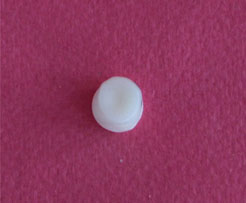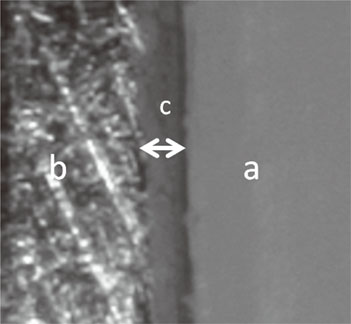J Adv Prosthodont.
2015 Jun;7(3):233-239. 10.4047/jap.2015.7.3.233.
The effect of various veneering techniques on the marginal fit of zirconia copings
- Affiliations
-
- 1Department of Prosthodontics, Faculty of Dentistry, Shiraz University of Medical Sciences, Shiraz, Iran.
- 2Biomaterial Research Center, Department of Prosthodontics, Faculty of Dentistry, Shiraz University of Medical Sciences, Shiraz, Iran.
- 3Department of Prosthodontics, School of Dentistry, Shiraz University of Medical Sciences, Shiraz, Iran. taghvam@yahoo.com
- 4Department of Oral and Maxillofacial Pathology, Faculty of Dentistry, Shiraz University of Medical Sciences, Shiraz, Iran.
- KMID: 2284709
- DOI: http://doi.org/10.4047/jap.2015.7.3.233
Abstract
- PURPOSE
This study aimed to evaluate the fit of zirconia ceramics before and after veneering, using 3 different veneering processes (layering, press-over, and CAD-on techniques).
MATERIALS AND METHODS
Thirty standardized zirconia CAD/CAM frameworks were constructed and divided into three groups of 10 each. The first group was veneered using the traditional layering technique. Press-over and CAD-on techniques were used to veneer second and third groups. The marginal gap of specimens was measured before and after veneering process at 18 sites on the master die using a digital microscope. Paired t-test was used to evaluate mean marginal gap changes. One-way ANOVA and post hoc tests were also employed for comparison among 3 groups (alpha=.05).
RESULTS
Marginal gap of 3 groups was increased after porcelain veneering. The mean marginal gap values after veneering in the layering group (63.06 microm) was higher than press-over (50.64 microm) and CAD-on (51.50 microm) veneered groups (P<.001).
CONCLUSION
Three veneering methods altered the marginal fit of zirconia copings. Conventional layering technique increased the marginal gap of zirconia framework more than pressing and CAD-on techniques. All ceramic crowns made through three different veneering methods revealed clinically acceptable marginal fit.
Keyword
Figure
Cited by 1 articles
-
Verification of a computer-aided replica technique for evaluating prosthesis adaptation using statistical agreement analysis
Hang-Nga Mai, Kyeong Eun Lee, Kyu-Bok Lee, Seung-Mi Jeong, Seok-Jae Lee, Cheong-Hee Lee, Seo-Young An, Du-Hyeong Lee
J Adv Prosthodont. 2017;9(5):358-363. doi: 10.4047/jap.2017.9.5.358.
Reference
-
1. Sadowsky SJ. An overview of treatment considerations for esthetic restorations: a review of the literature. J Prosthet Dent. 2006; 96:433–442.2. Liu PR. A panorama of dental CAD/CAM restorative systems. Compend Contin Educ Dent. 2005; 26:507–508.3. Miyazaki T, Hotta Y, Kunii J, Kuriyama S, Tamaki Y. A review of dental CAD/CAM: current status and future perspectives from 20 years of experience. Dent Mater J. 2009; 28:44–56.4. Bachhav VC, Aras MA. Zirconia-based fixed partial dentures: a clinical review. Quintessence Int. 2011; 42:173–182.5. Contrepois M, Soenen A, Bartala M, Laviole O. Marginal adaptation of ceramic crowns: a systematic review. J Prosthet Dent. 2013; 110:447–454.6. Jacobs MS, Windeler AS. An investigation of dental luting cement solubility as a function of the marginal gap. J Prosthet Dent. 1991; 65:436–442.7. Björn AL, Björn H, Grkovic B. Marginal fit of restorations and its relation to periodontal bone level. II. Crowns. Odontol Revy. 1970; 21:337–346.8. Schwartz NL, Whitsett LD, Berry TG, Stewart JL. Unserviceable crowns and fixed partial dentures: life-span and causes for loss of serviceability. J Am Dent Assoc. 1970; 81:1395–1401.9. Bergenholtz G, Cox CF, Loesche WJ, Syed SA. Bacterial leakage around dental restorations: its effect on the dental pulp. J Oral Pathol. 1982; 11:439–450.10. Heintze SD. Systematic reviews: I. The correlation between laboratory tests on marginal quality and bond strength. II. The correlation between marginal quality and clinical outcome. J Adhes Dent. 2007; 9:77–106.11. McLean JW, von Fraunhofer JA. The estimation of cement film thickness by an in vivo technique. Br Dent J. 1971; 131:107–111.12. Euán R, Figueras-Álvarez O, Cabratosa-Termes J, Oliver-Parra R. Marginal adaptation of zirconium dioxide copings: influence of the CAD/CAM system and the finish line design. J Prosthet Dent. 2014; 112:155–162.13. Holmes JR, Sulik WD, Holland GA, Bayne SC. Marginal fit of castable ceramic crowns. J Prosthet Dent. 1992; 67:594–599.14. Holmes JR, Bayne SC, Holland GA, Sulik WD. Considerations in measurement of marginal fit. J Prosthet Dent. 1989; 62:405–408.15. Balkaya MC, Cinar A, Pamuk S. Influence of firing cycles on the margin distortion of 3 all-ceramic crown systems. J Prosthet Dent. 2005; 93:346–355.16. Luthardt RG, Bornemann G, Lemelson S, Walter MH, Hüls A. An innovative method for evaluation of the 3-D internal fit of CAD/CAM crowns fabricated after direct optical versus indirect laser scan digitizing. Int J Prosthodont. 2004; 17:680–685.17. Pelekanos S, Koumanou M, Koutayas SO, Zinelis S, Eliades G. Micro-CT evaluation of the marginal fit of different In-Ceram alumina copings. Eur J Esthet Dent. 2009; 4:278–292.18. Sorensen JA. A standardized method for determination of crown margin fidelity. J Prosthet Dent. 1990; 64:18–24.19. Kanat B, Cömlekoğlu EM, Dündar-Çömlekoğlu M, Hakan Sen B, Ozcan M, Ali Güngör M. Effect of various veneering techniques on mechanical strength of computer-controlled zirconia framework designs. J Prosthodont. 2014; 23:445–455.20. Wimmer T, Erdelt KJ, Eichberger M, Roos M, Edelhoff D, Stawarczyk B. Influence of abutment model materials on the fracture loads of three-unit fixed dental prostheses. Dent Mater J. 2014; 33:717–724.21. Tsalouchou E, Cattell MJ, Knowles JC, Pittayachawan P, McDonald A. Fatigue and fracture properties of yttria partially stabilized zirconia crown systems. Dent Mater. 2008; 24:308–318.22. Beuer F, Schweiger J, Eichberger M, Kappert HF, Gernet W, Edelhoff D. High-strength CAD/CAM-fabricated veneering material sintered to zirconia copings-a new fabrication mode for all-ceramic restorations. Dent Mater. 2009; 25:121–128.23. Pera P, Gilodi S, Bassi F, Carossa S. In vitro marginal adaptation of alumina porcelain ceramic crowns. J Prosthet Dent. 1994; 72:585–590.24. Shearer B, Gough MB, Setchell DJ. Influence of marginal configuration and porcelain addition on the fit of In-Ceram crowns. Biomaterials. 1996; 17:1891–1895.25. Castellani D, Baccetti T, Clauser C, Bernardini UD. Thermal distortion of different materials in crown construction. J Prosthet Dent. 1994; 72:360–366.26. Pak HS, Han JS, Lee JB, Kim SH, Yang JH. Influence of porcelain veneering on the marginal fit of Digident and Lava CAD/CAM zirconia ceramic crowns. J Adv Prosthodont. 2010; 2:33–38.27. Fahmy NZ. Influence of veneering materials on the marginal fit and fracture resistance of an alumina core system. J Prosthodont. 2011; 20:45–51.28. Kohorst P, Brinkmann H, Dittmer MP, Borchers L, Stiesch M. Influence of the veneering process on the marginal fit of zirconia fixed dental prostheses. J Oral Rehabil. 2010; 37:283–291.29. Sulaiman F, Chai J, Jameson LM, Wozniak WT. A comparison of the marginal fit of In-Ceram, IPS Empress, and Procera crowns. Int J Prosthodont. 1997; 10:478–484.30. Cho SH, Nagy WW, Goodman JT, Solomon E, Koike M. The effect of multiple firings on the marginal integrity of pressable ceramic single crowns. J Prosthet Dent. 2012; 107:17–23.31. Miura S, Inagaki R, Kasahara S, Yoda M. Fit of zirconia allceramic crowns with different cervical margin designs, before and after porcelain firing and glazing. Dent Mater J. 2014; 33:484–489.32. Rosensteil SF, Land MF, Fujimoto J. Contemporary fixed prosthodontics. Tooth preparation for All-ceramic restorations. 4th ed. St. Louis: Elsevier;2006. p. 326.33. Alghazzawi TF, Liu PR, Essig ME. The effect of different fabrication steps on the marginal adaptation of two types of glass-infiltrated ceramic crown copings fabricated by CAD/CAM technology. J Prosthodont. 2012; 21:167–172.34. Sorensen JA. A standardized method for determination of crown margin fidelity. J Prosthet Dent. 1990; 64:18–24.35. Ushiwata O, de Moraes JV. Method for marginal measurements of restorations: accessory device for toolmakers microscope. J Prosthet Dent. 2000; 83:362–366.36. Christensen GJ. Marginal fit of gold inlay castings. J Prosthet Dent. 1966; 16:297–305.37. Euán R, Figueras-Álvarez O, Cabratosa-Termes J, Brufau-de Barberà M, Gomes-Azevedo S. Comparison of the marginal adaptation of zirconium dioxide crowns in preparations with two different finish lines. J Prosthodont. 2012; 21:291–295.38. Kokubo Y, Ohkubo C, Tsumita M, Miyashita A, Vult von Steyern P, Fukushima S. Clinical marginal and internal gaps of Procera AllCeram crowns. J Oral Rehabil. 2005; 32:526–530.39. Lee KB, Park CW, Kim KH, Kwon TY. Marginal and internal fit of all-ceramic crowns fabricated with two different CAD/CAM systems. Dent Mater J. 2008; 27:422–426.40. Bhowmik H, Parkhedkar R. A comparison of marginal fit of glass infiltrated alumina copings fabricated using two different techniques and the effect of firing cycles over them. J Adv Prosthodont. 2011; 3:196–203.41. Weaver JD, Johnson GH, Bales DJ. Marginal adaptation of castable ceramic crowns. J Prosthet Dent. 1991; 66:747–753.42. DeHoff PH, Barrett AA, Lee RB, Anusavice KJ. Thermal compatibility of dental ceramic systems using cylindrical and spherical geometries. Dent Mater. 2008; 24:744–752.43. Nielsen JP, Tuccillo JJ. Calculation of interfacial stress in dental porcelain bonded to gold alloy substrate. J Dent Res. 1972; 51:1043–1047.44. Aboushelib MN, Feilzer AJ, de Jager N, Kleverlaan CJ. Prestresses in bilayered all-ceramic restorations. J Biomed Mater Res B Appl Biomater. 2008; 87:139–145.45. Isgrò G, Wang H, Kleverlaan CJ, Feilzer AJ. The effects of thermal mismatch and fabrication procedures on the deflection of layered all-ceramic discs. Dent Mater. 2005; 21:649–655.46. Fairhurst CW, Anusavice KJ, Hashinger DT, Ringle RD, Twiggs SW. Thermal expansion of dental alloys and porcelains. J Biomed Mater Res. 1980; 14:435–446.47. Isgrò G, Kleverlaan CJ, Wang H, Feilzer AJ. Thermal dimensional behavior of dental ceramics. Biomaterials. 2004; 25:2447–2453.
- Full Text Links
- Actions
-
Cited
- CITED
-
- Close
- Share
- Similar articles
-
- Influence of porcelain veneering on the marginal fit of Digident and Lava CAD/CAM zirconia ceramic crowns
- A comparison of marginal fit of glass infiltrated alumina copings fabricated using two different techniques and the effect of firing cycles over them
- Comparison of the fit accuracy of zirconia-based prostheses generated by two CAD/CAM systems
- Effect of anatomic, semi-anatomic and non-anatomic occlusal surface tooth preparations on the adaptation of zirconia copings
- A STUDY ON THE DISTORTION OF THE COPINGS FOR CERAMOMETAL CROWNS DURING REPEATED FIRING






